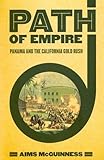Path of Empire : Panama and the California Gold Rush / Aims McGuinness.
Material type: TextSeries: The United States in the WorldPublisher: Ithaca, NY : Cornell University Press, [2016]Copyright date: ©2016Description: 1 online resource (264 p.) : 7 halftones, 1 table, 6 mapsContent type:
TextSeries: The United States in the WorldPublisher: Ithaca, NY : Cornell University Press, [2016]Copyright date: ©2016Description: 1 online resource (264 p.) : 7 halftones, 1 table, 6 mapsContent type: - 9781501707346
- 327.730728709/034
- E183
- online - DeGruyter
| Item type | Current library | Call number | URL | Status | Notes | Barcode | |
|---|---|---|---|---|---|---|---|
 eBook
eBook
|
Biblioteca "Angelicum" Pont. Univ. S.Tommaso d'Aquino Nuvola online | online - DeGruyter (Browse shelf(Opens below)) | Online access | Not for loan (Accesso limitato) | Accesso per gli utenti autorizzati / Access for authorized users | (dgr)9781501707346 |
Frontmatter -- Contents -- Acknowledgments -- Prelude:April 15, 1856 -- Introduction: In the Archive of Loose Leaves -- Chapter 1. California in Panama -- Chapter 2. The Panama Railroad and the Conquest of the Gold Rush -- Chapter 3. Sovereignty on the Isthmus -- Chapter 4.“We Are Not in the United States Here” -- Chapter 5.U.S. Empire and the Boundaries of Latin America -- Conclusion: Conversations in the Museum of History -- Coda:With Dust in Our Eyes -- Notes -- Bibliography -- Index
restricted access online access with authorization star
http://purl.org/coar/access_right/c_16ec
Most people in the United States have forgotten that tens of thousands of U.S. citizens migrated westward to California by way of Panama during the California Gold Rush. Decades before the completion of the Panama Canal in 1914, this slender spit of land abruptly became the linchpin of the fastest route between New York City and San Francisco—a route that combined travel by ship to the east coast of Panama, an overland crossing to Panama City, and a final voyage by ship to California. In Path of Empire, Aims McGuinness presents a novel understanding of the intertwined histories of the California Gold Rush, the course of U.S. empire, and anti-imperialist politics in Latin America. Between 1848 and 1856, Panama saw the building, by a U.S. company, of the first transcontinental railroad in world history, the final abolition of slavery, the establishment of universal manhood suffrage, the foundation of an autonomous Panamanian state, and the first of what would become a long list of military interventions by the United States.Using documents found in Panamanian, Colombian, and U.S. archives, McGuinness reveals how U.S. imperial projects in Panama were integral to developments in California and the larger process of U.S. continental expansion. Path of Empire offers a model for the new transnational history by unbinding the gold rush from the confines of U.S. history as traditionally told and narrating that event as the history of Panama, a small place of global importance in the mid-1800s.
Mode of access: Internet via World Wide Web.
In English.
Description based on online resource; title from PDF title page (publisher's Web site, viewed 26. Apr 2024)


